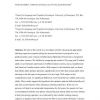438 search results - page 71 / 88 » Pervasive Theory of Memory |
ATAL
2010
Springer
13 years 9 months ago
2010
Springer
Ant robots have very low computational power and limited memory. They communicate by leaving pheromones in the environment. In order to create a cooperative intelligent behavior, ...
GECCO
2008
Springer
13 years 9 months ago
2008
Springer
We are interested in engineering smart machines that enable backtracking of emergent behaviors. Our SSNNS simulator consists of hand-picked tools to explore spiking neural network...
CJ
2006
13 years 8 months ago
2006
Anonymous channels or similar techniques that can achieve sender's anonymity play important roles in many applications. However, they will be meaningless if cryptographic prim...
COGSCI
2007
13 years 8 months ago
2007
The sounds that make up spoken words are heard in a series and must be mapped rapidly onto words in memory because their elements, unlike those of visual words, cannot simultaneou...
JOLLI
2008
13 years 8 months ago
2008
The aim of this article is to investigate whether choosing the appropriate referring expression requires taking into account the hearer's perspective, as is predicted under so...

